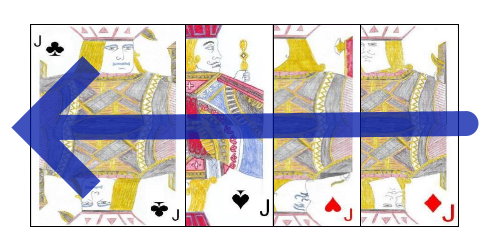
Bauernheinrich is a rather rare game, and is generally only played in certain areas of Northern Germany. However, despite this, the game can make a great addition to any card players repertoire of games. Roughly translated into English, the game's name would be Farmer Henry. Bauernheinrich is designed to be played by four players, each playing independently.
While traditionally played with the classic German pack, the game can
also be accommodated by the more common French pack. In this case the
reduced Skat deck should be used. This deck consists of all cards from
the following ranks in a standard deck; Aces, Kings, Queens, Jacks, 10's,
9's, 8's, 7's. The ranking of the cards in each suit is as follows (from
high to low): Ace, King, Queen, 10, 9, 8, 7. The Jacks in this game have
a special role as the permanent trump suit, outranking any other cards. As
such, these four cards are not considered to be the member of any other
suit. Amongst the Jacks, there is also a relative ranking as follows
(also listed from high to low): Jack of Clubs, Jack of Spades, Jack of Hearts, Jack of Diamonds.
Determination of first dealer and seating positions can be by done in a variety of methods, with draw for low cards one such method commonly used. Each player would draw one card from the shuffled deck, with players taking seats at the table in order of cards drawn, from lowest to highest. The player drawing the lowest card of all is set as the first dealer. Thereafter the role of the dealer rotates around the table in a counter-clockwise direction.
Once the players are seated at the table and the first dealer determined, this player should thoroughly shuffle the cards and offer the deck to the player at his right to cut. After the cut, the dealer then begins dealing the cards around the table, starting the with the player at his immediate right and continuing in a counter-clockwise direction. He first deals a three card packet to each player, then a two card packet and a final three card packet. Each player should receive a total of eight face-down cards to form his hand.
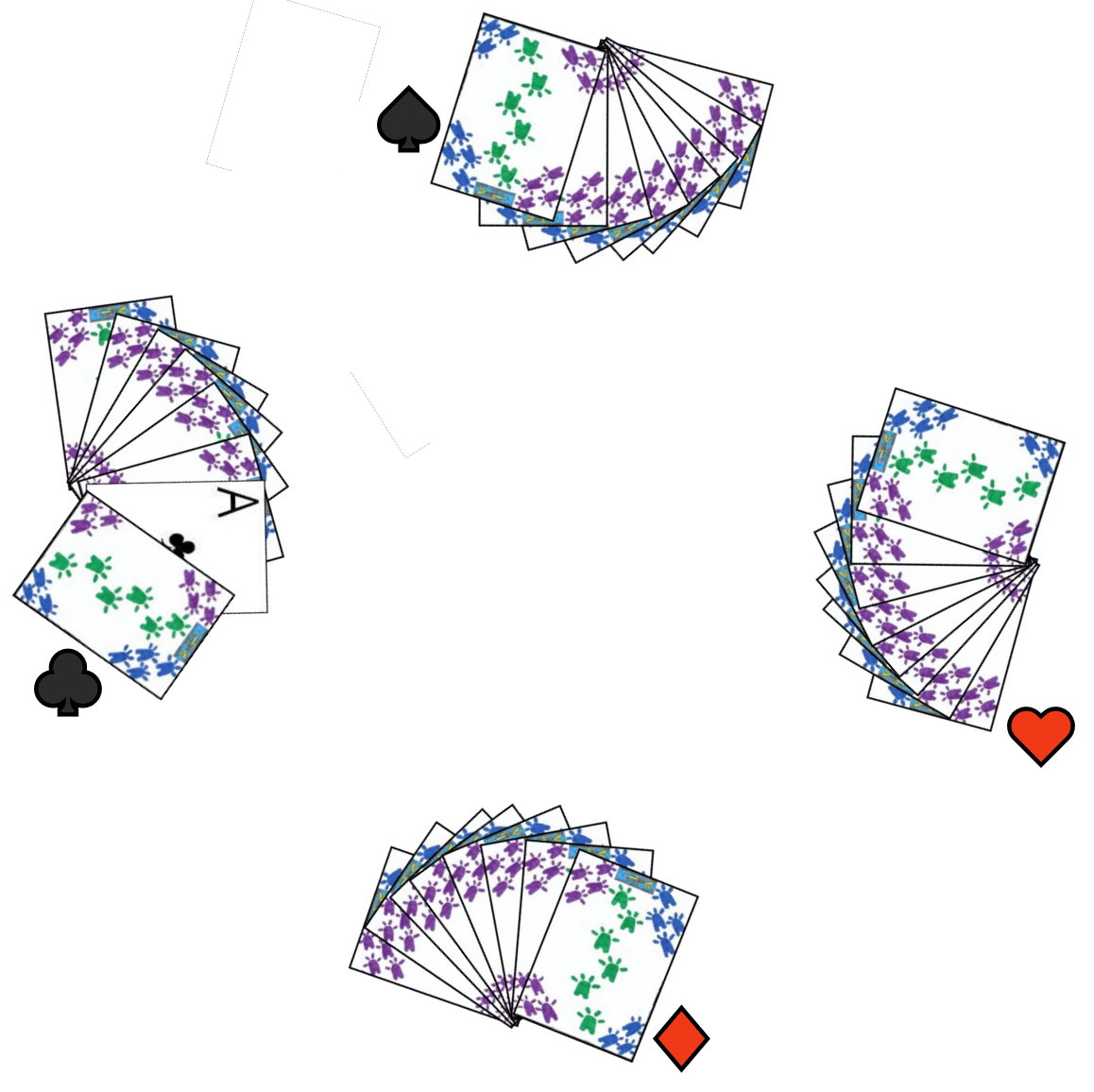
Each player is considered to have his own unique trump suit. After each player
has received his hand, the player who has received the Ace of Clubs in his hand must announce this by calling
"Hier ist Kreuz!" (or "I have clubs!"). Clubs thus becomes this player's trump suit for the hand. Each
additional player is then assigned a different trump suit based on their position at the table. The next player in a clockwise rotation from the player having the Ace of Clubs has his trump suit set to Spades, the next player in a clockwise rotation Hearts, and the last player has Diamonds as his personal trump suit.
Once it has been determined what each player's personal trump suit is for the hand, the player with the Ace of Clubs will lead the first card to the first trick. In doing so, he may lead any card of choice from his hand.
The next player in a counter-clockwise direction than has the opportunity to play a card from his hand to the same trick. However, he may only play a card to the trick if he can play a higher ranked card to the trick, based on the following ranking criteria:
- A higher card of the suit led to the trick can then be played to that
same trick.
- If the player does not have a card of that suit, he may play any card from his personal trump suit (if a different suit was led to that trick).
- Any Jack, if a Jack was not originally led to this trick. If a
Jack was previously played to the trick, the player may play a higher ranked
Jack (as per the ranking of the four Jacks as described previously).
If unable (or unwilling) to play a higher such card, the player must
instead take all the current cards from the trick, adding these cards to
his current hand. If this occurs, the turn passes to the next player in a
counter-clockwise direction from the player taking these cards, who may
then lead any card of his choice from his hand to start the next trick.
If a player is able to play a higher card to the trick, the turn then moves to the next player in a counter-clockwise direction. This player must then play a card higher than the last card played to that
same trick with the same stipulations as for the previous player.
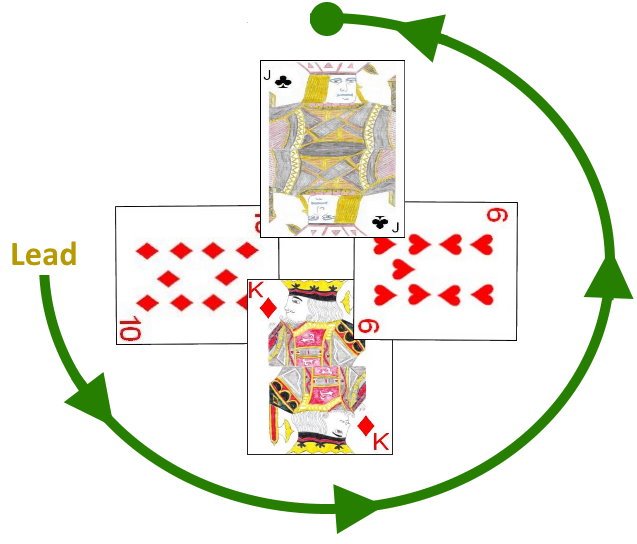
If no player has been forced to pick up the cards from the trick (each having been able to play a higher card than the previous player), the four cards to the completed trick are set aside and out of play. In that case, the leader to that trick then leads the first card (any card of choice from his hand) to start the next trick.
The game continues until one player manages to legally play his last card to a trick on his turn, after which that player drops from the game and declared the first winner. The game continues, however with the three remaining players. With only three active players each trick would then consist of exactly three cards. This continues until the next player manages to play his last card, after which the last two players attempt to be the first of the two to run out of cards from the hand, in the play of two card tricks. If the winner of a trick was the player who should have led the next trick, but cannot as he has run out of cards, the turn passes to the next player in a counter-clockwise direction from the player who ran out of cards.
The first player to run out of cards is considered the
game winner and the last player with cards remaining in his hand is said to lose the hand.
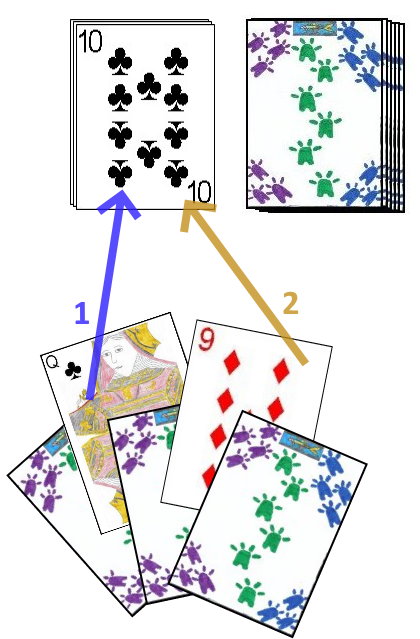 Dudák
Dudák: Dudák is a similar shedding type game which is quite similar to Bauernheinrich. The name of the game translates to Bagpiper. Similar to Bauernheinrich,
this game is usually played by four players using a 32 card German deck. This game originated in
Czechoslovakia and is still somewhat played there, although less commonly than it once was. The ranking of the cards in the deck as used for this game are as
follows (from highest to lowest): Ace, King, Queen, Jack, 10, 9, 8, 7.
The determination of seating position and first dealer can be done using the same method as Bauernheinrich, with draw for high cards a common method. The loser of each hand then deals the next and.
Once selected the dealer than deals the cards in a clockwise rotation such that each player receives a total of eight cards. The player to the dealer's left has the first play.
If the play pile is currently empty (as it will be on the first play of the hand), a player may play any card of choice from his hand to start the play pile. On turns in which the play pile is not empty, the player has several options, depending on if the player has already, during this hand, declared his personal trump suit:
- If the player is able and willing to beat the current top card of the play pile he may do so. In order to beat the card he must play a card of higher denomination, in the same suit as that current top card on the play pile. After playing such a card he may then play any other card of choice still remaining in his hand to the top of the play pile. Once the player plays this second card, his turn immediately ends.
- If the player has already declared a personal trump suit, he may, if able and willing, play any card of that trump suit to beat the card (unless the top card is already of that player's personal trump suit in which case he must play a higher card in that same suit to beat the card). If able to beat the
top card he then plays a second card from his hand, which may be any card of choice remaining in his hand to the top of the play pile.
- If the player has already declared his personal trump suit for this hand, and if that player is unable or unwilling to beat the top card of the pile, he must take entire current play pile into his hand, ending his turn.
- If the player has not yet declared his personal trump suit for this hand, he may begin taking cards, one-at-a-time from the top of the play pile into his hand until he finds a card he can beat. He would then beat this card as normal, then playing any second card of choice from his hand. The player may not use any cards taken from the play pile to beat the card exposed, however. If the player ends up taking the last card from the play pile, his turn immediately ends and the next player in turn may start a new play pile by playing any card of his choice.
At the beginning of a player's turn, if he has not already done so, that player may declare his personal trump suit for the hand. He may not declare a trump suit that has already been selected by another player on this same hand. Once three of the four players have declared a trump suit, the remaining player is then automatically assigned the last suit which has not yet been chosen during the hand. Once a player declares a personal trump suit, he may then use cards of that suit to beat any card from another suit on his turn.
If a player has only one card in his hand and, on his turn, uses that one card to beat the top card of the play pile the entire play pile is then discard and no longer used during the current game.
Play then resumes with the next player in turn who still has cards
remaining in hand, playing any card of choice from his hand to start a
new play pile.
Once a player manages to play his last card legally during his turn, he drops from the game, with this continuing until only one player still has cards remaining during the hand, with that player said to have lost the hand.
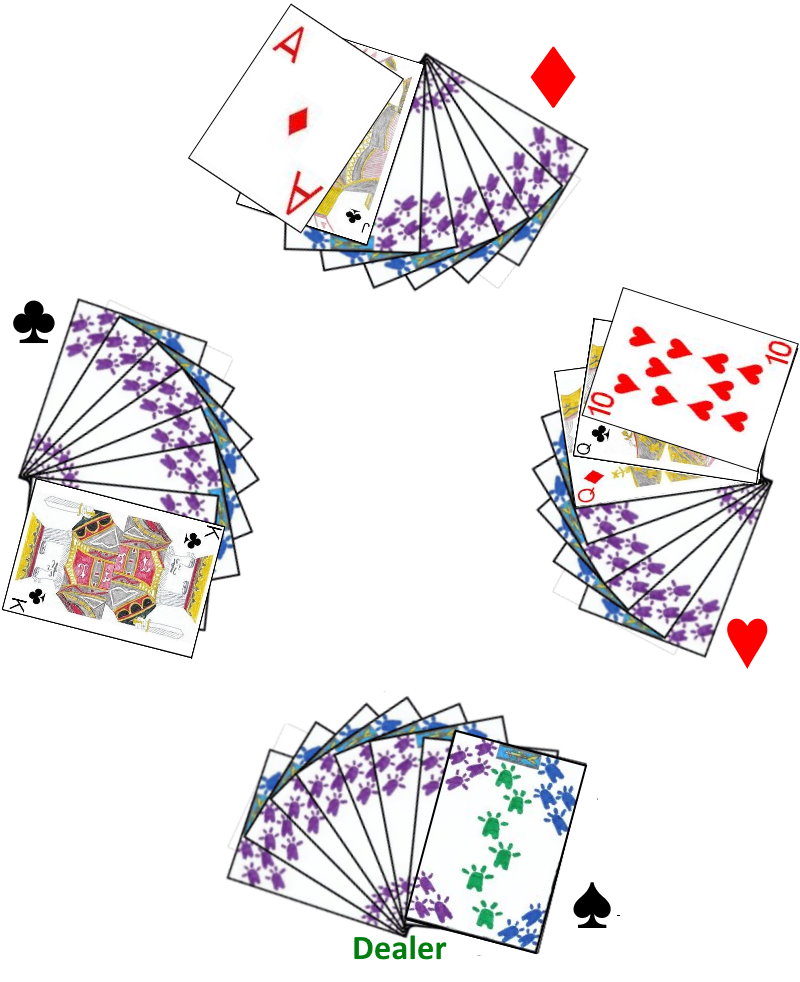 Open Dudák
Open Dudák: This variant is played
identically to standard Dudák with one major difference. In Open
Dudák, the cards from the initial deal are left face-down on the table in front of each player
and the player does not look at these cards. After the deal is completed, the player to the dealer's immediate left turns up the top card of his dealt cards. The suit of this card is set as the trump suit for this player. After this, the second player then turns a card from his hand to determine his own personal trump suit. If this card is the same suit as that drawn by the first player he continues revealing cards from his hand until he shows a card which is of a suit not already set for another player. If he continues to draw cards already selected as another player's trump suit he continues revealing cards until a unique trump suit is shown. This continues with each player around the table. Once these trump suits have been determined, they should remain as that player's personal trump suit for the entire game. It should also be noted that since the identify of each player's trump suit is known in advance, if a player opts to pick up the play pile on his turn, he must take entire pile immediately into his hand, ending his turn.
In all other aspects Open Dudák is played identically to the standard game as described above.
Pocket Dudák: Pocket Dudák is also a direct variant of standard Dudák. In this variant, the last card dealt to each player is set aside, face-down from the rest of the player's hand which will thus indicate that player's personal trump suit for the hand. The player may not take that card yet into his hand, but may look at it's face. The suit of this card determines that player's personal trump suit for the hand. Once a player decides, during his turn to reveal his trump card, he thus turns over the card to reveal it to all the other player's and then adds it to his hand after which it can be played to the play pile as normal. This card may never be added to a player's hand or played until that player has announced his trump suit (by displaying this card). In all other aspects this variant is played similar to the standard game of Dudák as described above.
Copyright © 2015
CatsAtCards.com. All rights reserved.
 Bauernheinrich is a rather rare game, and is generally only played in certain areas of Northern Germany. However, despite this, the game can make a great addition to any card players repertoire of games. Roughly translated into English, the game's name would be Farmer Henry. Bauernheinrich is designed to be played by four players, each playing independently.
Bauernheinrich is a rather rare game, and is generally only played in certain areas of Northern Germany. However, despite this, the game can make a great addition to any card players repertoire of games. Roughly translated into English, the game's name would be Farmer Henry. Bauernheinrich is designed to be played by four players, each playing independently.
 Each player is considered to have his own unique trump suit. After each player
has received his hand, the player who has received the Ace of Clubs in his hand must announce this by calling
"Hier ist Kreuz!" (or "I have clubs!"). Clubs thus becomes this player's trump suit for the hand. Each
additional player is then assigned a different trump suit based on their position at the table. The next player in a clockwise rotation from the player having the Ace of Clubs has his trump suit set to Spades, the next player in a clockwise rotation Hearts, and the last player has Diamonds as his personal trump suit.
Each player is considered to have his own unique trump suit. After each player
has received his hand, the player who has received the Ace of Clubs in his hand must announce this by calling
"Hier ist Kreuz!" (or "I have clubs!"). Clubs thus becomes this player's trump suit for the hand. Each
additional player is then assigned a different trump suit based on their position at the table. The next player in a clockwise rotation from the player having the Ace of Clubs has his trump suit set to Spades, the next player in a clockwise rotation Hearts, and the last player has Diamonds as his personal trump suit.
 If no player has been forced to pick up the cards from the trick (each having been able to play a higher card than the previous player), the four cards to the completed trick are set aside and out of play. In that case, the leader to that trick then leads the first card (any card of choice from his hand) to start the next trick.
If no player has been forced to pick up the cards from the trick (each having been able to play a higher card than the previous player), the four cards to the completed trick are set aside and out of play. In that case, the leader to that trick then leads the first card (any card of choice from his hand) to start the next trick.

